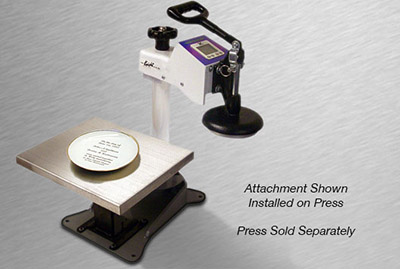HOW TO HEAT PRESS A PLATE
 George Knight DC-PLATE
George Knight DC-PLATEHeat presses are machines that use heat and pressure to apply graphics, and are a great solution for printing on plates. This tutorial gives some tips to get you started with heat pressing on plates on many types of heat presses, including Geo Knight presses.
Printing on plates requires a press that applies even pressure when closing. The DC-PLATE circular heating block attachment on a swing-sway combo press from George Knight is an excellent choice for printing on plates. A heat pressing puck can also be used to press plates with a flat press.
Ideal settings vary with specific materials. It is important to find a plate that can withstand the temperature required for a heat transfer.
A special type of paper called "heat transfer paper" is often used as the medium for transferring an image to your plate. To use transfer paper, the next step would be to get the image you'd like onto the transfer paper. Typically, you'll need to reverse the image (make it mirror image) using image-editing software so the image prints properly on the plate. Check to see what kind of printer ink is best for the material you are printing on and your transfer paper. Once you have the image printed onto transfer paper, trim the paper to fit the plate (a utility knife or scissors should do the trick).
Turn your heat press on, and set it to the proper heat and pressure settings. Be sure to check with your heat press and ink manufacturers to determine how hot to set your heat press, and how long to press the plate. It's also smart to wear heat protective gloves when handling hot surfaces. Position your artwork face-down on the plate, and hold it in place with an adhesive such as ProSpray. It's often recommended to lay a sheet of protective paper on top of the artwork to keep it from sticking to the pressing surface.
Now you're ready to go ahead and press to transfer the artwork onto your plate! A press like the DC-PLATE makes it easy to position and press the plate. If you're using a puck or something else, make sure to check with your manufacturer to use it properly. When your plate has been in the press for the proper amount of time, open the press, remove your plate (don't forget the protective gloves), and set aside to cool. Follow any instructions specific to your transfer paper when removing the transfer sheet.
Visit our Learn page for more information on heat pressing, or feel free to Contact Us with any questions or requests for special projects. We would be pleased to provide a solution.
Learn more about the DC-Plate from George Knight.
To learn more about or to buy George Knight heat presses, visit HeatPress.com.
|







